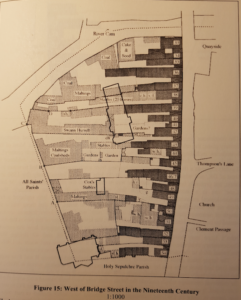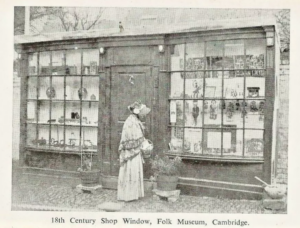There is one very prominent item in our collection that even we overlook: the shop front of the Enid Porter building!
Originally from 45 Bridge Street, it was a shop known long ago as ‘Le Cage’ and subject to demolition in the period 1937-9 by when St John’s College had acquired ownership of much of the western side of Bridge Street; the College proceeded to demolish its property in Bridge Street to build the new Master’s Lodge. Enid Porter, curator of the Museum Cambridge from 1947 – 1976, wrote a detailed article on what was lost at that time. But another more detailed source of what used to be at this location, as at every other location in the nearby streets, is that of T.E. Faber, ‘An Intimate History of the Parish of St Clement Cambridge.’
T E Faber’s work looked at the history of the individual plots in the parish, including those in Bridge Street. Whilst the buildings may have been demolished and rebuilt, the plot dimensions didn’t change until the 20th century. As a result we know that no.45 Bridge Street was in 1573 known as ‘le Cage.’ We can trace it through various ownerships until by 1911 it was used by William Chapman, a butcher.

The story has it that, after the shop-front was scheduled for demolition, someone at the newly established Cambridge and County Folk Museum asked St John’s for the 18th century shop-front to be given to the museum. They refused and so it was surreptitiously dismantled and removed over a number of nights. Allegedly many of the sections were even cycled under cover of darkness from their old to new location.
The area around Bridge Street is especially interesting when looking at the history, preservation and destruction of the built environment of Cambridge in the long term. Thanks to the work of T E Faber we have as detailed a record of what has been at this location over the past seven hundred or more years as probably any other location in the country. We can see how usage of the numerous properties changed function and ownership over hundreds of years, thanks to the records kept by colleges of the land ownership and leases, and we can therefore see how much has been lost or changed over time.
Capturing Cambridge has tried to incorporate Faber’s research into its timeline of the buildings in the area so that their occupancy can be understood by those in the 21st century. Such research could be carried out for many other parts of Cambridge. We have started this research by looking at census information from 1841 but there is much information from before this date that could be researched and made available through our website to those interested in looking back at the social and architectural history of Cambridge.
Unlike a modern window frame the conservation and care of this exquisite frontage is a more complicated process. Involving careful preparation and care of the wood, putty and of course ensuring the materials and paints used continue to protect it from the elements for years to come. More information about conservation of our building and collection items can be found in our blogs. To contribute to helping us continue this care please consider making a donation.
Donate – The Museum of Cambridge
By Roger Lilley
